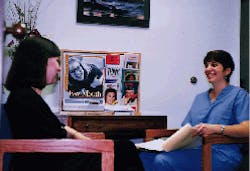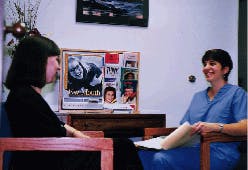Managed care practice places emphasis on hygienists preventive therapy services
Kristen Simmons, RDH
Have you ever worked with five hygienists at once? Have you attended a hygiene staff meeting with 60 dental hygienists? At the Williamette Dental Group, it is not uncommon to work in a location with 17 operatories, six general dentists, and three specialists.
The Williamette Dental Group is one of the nation`s largest leading private group practices. We have more than 20 locations with 90 dentists and 60 hygienists. In addition, this large dental group is a pioneer in managed care.
Much attention is given to managed care, although often from a negative perspective. Through our carefully designed managed-care system, we see that the quality of care is even better, and managed care is a step forward. The patients are better informed and are active participants in their oral care.
The hygienists also report more job satisfaction. More preventive therapy is possible as opposed to dental prophylaxis. The staff feel more in touch with the patients` needs.
The transformation occurring in today`s health care delivery requires fresh and innovative strategies and wisdom. It is vital that the hygienist recognize how the various systems work for the patient whether it is capitation, fee-for-service, or a state-funded dental plan. In the long run, preventive health practices will lower the cost of dental health and decrease the pain and trauma that occur from dental neglect.
Who is managing the care?
Our philosophy is that the patient is a partner in care. Our new patients are introduced into our practice in a different way. At the time of the initial call for an appointment, a new patient work-up is started. Our staff obtains the insurance information over the telephone. The new patient is sent company information and a medical/dental history form to be completed prior to their scheduled appointment.
The first appointment is always a consultation with a pre-assigned dentist. During the consultation, the appointed dentist reviews and evaluates the medical/dental history and dental questionnaire with the patient to decide the need for radiographs and to direct the treatment process.
Our doctors are trained to hear the patient`s expectations and to use this information to help motivate their interest in preventive care.
One managing doctor in the practice says, "We want our patients to understand that keeping teeth and gums healthy means less dental visits, and less trauma and pain. A beautiful smile can be possible through preventive measures.
"I would rather educate to avoid disease than repair dental disease that could have been prevented. I make no more or less money whether patients have no oral health problems or many."
After the initial visit with the patient, the doctor directs the dental assistant to gather the necessary information needed to help make a diagnosis. The dental assistant escorts the patient to a treatment room and begins the dental charting. The assistant introduces the patient to home-care techniques.
All assistants are trained to show patients the modified Bass tooth-brushing technique with a soft brush and flossing. The assistant spends a good portion of the visit on home-care instruction, showing how to work intraoral to help reduce bacterial plaque.
After the assistant is finished, the doctor returns to examine the patient. Examinations include head and neck assessments, periodontal probing, orthodontic screening, and treatment planning. Included in the treatment plan is an estimate of how much time it will take to perform a prophylaxis.
This routine is very different from a traditional practice where it is usually the hygienist who sees the patient first. Subsequently, we have found that patients understand the focus on prevention is the key to our practice and the hygienists spend 100 percent of their time delivering care. Furthermore, patients like being able to talk and visit with the dentist in a non-threatening setting prior to treatment.
Not stuck in a rut
Once the patient has reached the hygienist for a prophylaxis, we have already set the stage for home-care motivation. We now start the process of debridement or prophylaxis based on case type. All our offices have titan scalers, ultrasonics, large-handled carbide scalers (plus the traditional graceys).
We have thrown away the traditional six-month recall system and have a tailor-made system that fits the patient`s needs. Some patients come in every three months. The rest come in six or nine, or on a yearly basis. The patients are not "locked in" or rooted to a recall interval. If they improve, we see them less; if they have trouble, we set up oral hygiene visits to encourage improvements.
"You don`t have to sell anything," one hygienist says. You will, however, need to be innovative to help motivate oral health improvement, and be very creative with oral hygiene aids. How often under the fee-for-service plan do you have the opportunity to schedule a patient to determine compliance with the provided dental health education, to maintain and/or improve oral health?
In managed care, the patient makes an investment to maintain and improve the teeth and supporting tissues. Financially, the cost to provide dental health is less if patients are taking care of their mouths.
Cost containment is an issue in a large group practice as in any other practice. Instead of selling, we are promoting and motivating patients to reduce dental disease. Hygienists are treated more as therapists rather than the "tooth cleaners" that clean teeth every six months. Uniquely, as therapists we can stay very directed on the delivery of preventive care. The hygienist`s appointment time is utilized delivering hygiene services.
On the other hand, in most fee-for-service plans, the hygienist spends many hours waiting for paperwork to be filled out, insurance information to be gathered, or preauthorization for reimbursement of services.
Through managed care, we can provide more individualized care. It is wonderful to stay focused on the delivery of preventive services, such as pit-and-fissure sealants, home fluoride treatments, antimicrobials for periodontal problems, and a host of preventive tools. In addition, hygienists have more time to share and explore new product designs in home-care aids, thereby presenting the latest technological advances to our patients.
Our specialty is at our fingertips
Once our patients understand the reasons for removing bacterial plaque and are actively involved in the process, our dentists and hygienists in collaboration may send the patient to any of our specialists. An advantage of a large group practice is the partnership of periodontics, endodontics, oral surgery, pediatrics, and orthodontics. This is truly an unique opportunity to learn from each specialty. Consultations between the disciplines occur frequently which promotes professional education and knowledge.
One hygienist says, "Working with the pediatric doctor has given me greater confidence in dealing with apprehensive children. I see the way the doctor explains how he is going to proceed with treatment with a hands-on approach. This has helped me to feel more at ease when I see my patients. It`s great to be part of an organization that has so many diverse specialties that we can acquire knowledge about."
Another advantage of in-house specialists is that the dentist and specialist see the same chart/record. They can communicate through the record to one another. Each knows exactly the treatment process and needs of the patient. This is very useful especially when periodontal patients return to general dental offices. The hygienist can keep supporting the foundation the periohygienist has laid down. Perhaps even more important than the great communication that happens between the specialist and general dentist, the patient does not have replicated services. It`s a win-win situation.
This is an exciting time for RDHs since more patients are choosing managed care services. Hygienists can seize the opportunity to teach and excel at the delivery and execution of preventive treatments.
The key to our practice is prevention. All departments help to support and re-emphasize our goal. The patient is a partner in care. I am happy to deliver care in this manner. I can say in my years of service in the hygiene profession I did make a difference.
Kristen Simmons, RDH, practices with the Williamette Dental Group, P.C., in Beaverton, Ore. Questions about the managed care system that the group practice has implemented can be directed to her at 14025 SW Farmington Road, Suite 300, Beaverton, OR 97005.
Susan McElhany, DMD, consults with a new patient at the Williamette Dental Group.

